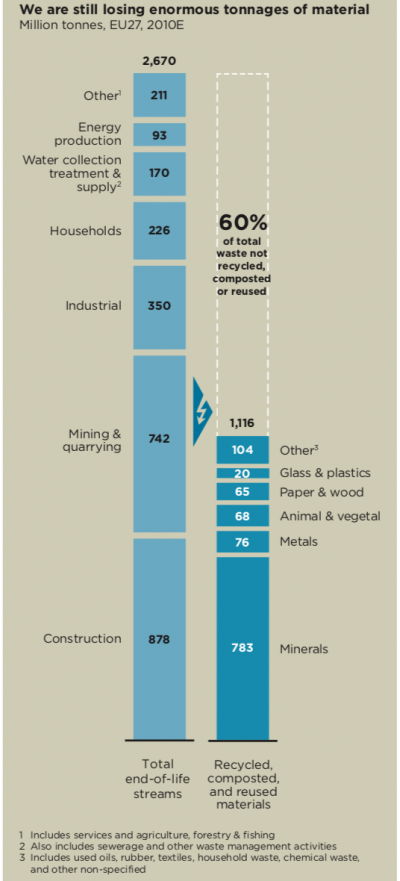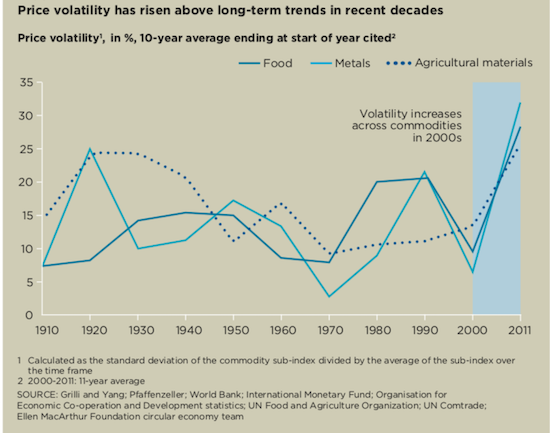What exactly is the circular economy and what role can surface engineering play?
The circular economy is a concept of sustainable consumption, driven by an industrial system that is restorative or regenerative by iteration and design.
A circular economy designs out waste as products are created for a cycle of disassembly and reuse, setting the circular economy apart from disposal and recycling – where large amounts of material, energy and labour invested in a product are lost.
The Ellen MacArthur Foundation, a leading body in the research and development of the circular economy, published a report in 2013 on the economic and business rationale for an accelerated transition to a circular economy for developed nations.
Focusing on Europe, the report, written in partnership with McKinsey & Company, highlights the increasing demand placed on the world’s finite resources to support the need for raw materials.
In 2010 some 65 billion tonnes of raw materials entered into the economic system, a figure that is expected to increase by 26% in 2020, reaching 82 billion tonnes.

Graph sourced from Ellen MacArthur Foundation; Towards the circular Economy, 2013
The report highlights that the figures on expected worldwide demand for raw materials simply don’t stack up if we are to continue the status quo of the current linear model for resource consumption; take – make – dispose.

Graph sourced from Ellen MacArthur Foundation; Towards the circular Economy, 2013
Achieving a circular economy model is challenging and requires radical thinking across product development, engineering, design and manufacture but the rewards, not only ecologically but also economically are there.
Based on detailed product level modelling it is estimated that, at EU level, the circular economy represents a net material cost saving of USD 340 to 380 billion pa for a ‘transition scenario’.
For a more widely adopted case, where reverse technologies, infrastructure and customer acceptance has matured, known as an ‘advanced scenario’ USD 520 to 630 billion pa net material cost savings across the EU are predicted.
The role of surface engineering in achieving a circular economy
Surface engineering has a crucial role to play in the move towards a circular economy.
Through involvement at the design and engineering stages, where future use can be mapped out and surface finishing processes specified, to reducing product toxicity for future applications, surface engineering and metallurgy expertise will help the move toward a circular economy.
The role of Surface Engineering: Design and development
In today’s linear usage model, a product is designed to fulfil a particular application, once that product has reached the end of its serviceable life it is disposed of or recycled back to its raw material.
Taking a circular economy approach means to design and engineer not just for one life but being mindful of the products second, third, fourth lifecycle. Understanding the parameters of any given part means understanding the longevity of its material structure and that’s where surface engineering expertise come in.
Surface Technology is the UK’s leading surface engineering and finishing specialist and our technical team work with customers across a wide variety of industries every day to maximise the longevity, reliability and performance of the components and products they manufacture.
A rich body of experience spanning decades across multiple industry sectors that add a great deal of value when it comes to understanding the potential of a part for reuse and remanufacture.
At the design and development stage surface engineering principles will not only help outline required service intervals and product lifespan but also how often an application can be re-coated whilst ensuring integrity and reliability.
If a part is unable to be reused due to integrity concerns, an appreciation of surface engineering can help outline future use in other areas or even industry sectors – subsea oil and gas parts used in tidal energy generation for example.
The role of Surface Engineering: Maximising lifespan
At the very core of surface engineering is the principle of maximising product lifespan, reliability and performance however this is very often seen as a task for a newly manufactured product.
In fact, taking a circular economy approach, surface engineering can map out, through an understanding of operating environment and performance requirements, when a part can be maintained and extend its lifespan.
Cost is very often a perceived barrier to doing this, however there are many cost-effective means of repairing and maintaining rather than replacing technology. At Surface Technology we regularly partner subsea oil and gas manufacturers to remanufacture technology for reuse, other applications include food manufacturing, automotive and aerospace.
Our sister company, SIFCO ASC, regularly partner manufacturers in the oil and gas, aerospace, mining and power generation sector to maintain and remanufacture products for reuse where they would otherwise be replaced.
The role of Surface Engineering: Opening up new applications
From use on the seabed to being re-purposed into a valve for snack food manufacturing, rail part to use in power generation, there are many applications that reach the end of their first product lifecycle that can, through intelligent engineering and surface engineering, be reinvigorated for a second life in a completely different application and sector.
Knowledge of the part’s surface capabilities, the toxicity of the coating or plating applied, the potential for removal of surface finishing, machining and any additional post treatment all help outline the engineering and economic viability of re-purposing technology.
In conclusion
Achieving the bold vision of a circular economy will take a multi-disciplinary, cross-sector, multi-national approach to achieve.
However, the environmental and economic benefits significantly outweigh the challenge.
At Surface Technology we will continue to partner manufacturers and suppliers of all sizes throughout the UK to maximise the longevity and performance of products.
We are currently exploring the role of surface engineering for further remanufacturing of subsea oil and gas technology and are looking to partner more manufacturers on the path to embracing sustainable manufacturing principles.
Contact us now to discuss your remanufacturing requirements and find out how our range of surface finishing services can help you push towards a circular economy.
Register below for our monthly email and stay up-to-date with the latest surface engineering white papers, case studies and innovation news.

